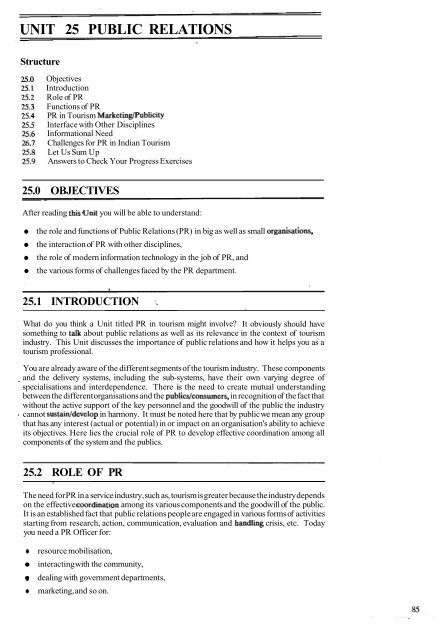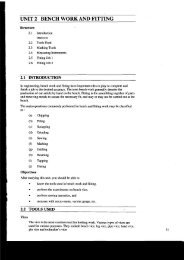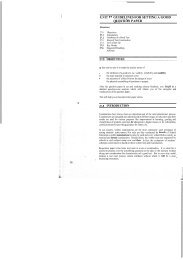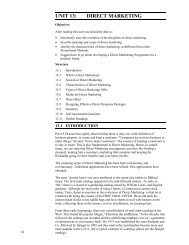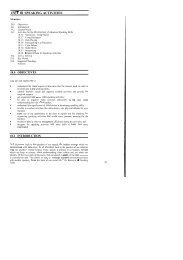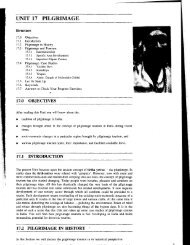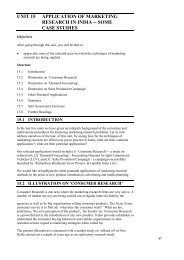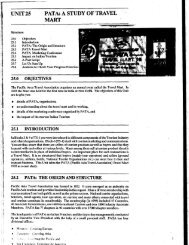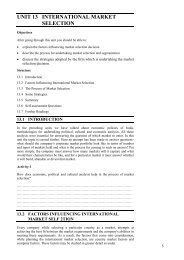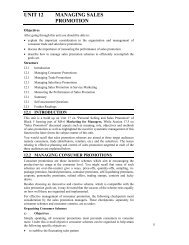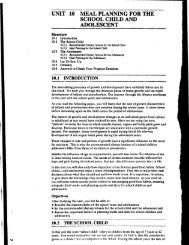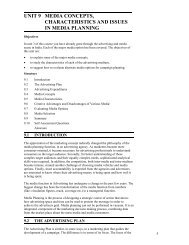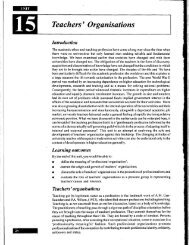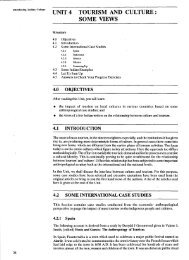UNIT 25 PUBLIC RELATIONS - eGyanKosh
UNIT 25 PUBLIC RELATIONS - eGyanKosh
UNIT 25 PUBLIC RELATIONS - eGyanKosh
You also want an ePaper? Increase the reach of your titles
YUMPU automatically turns print PDFs into web optimized ePapers that Google loves.
<strong>UNIT</strong> <strong>25</strong> <strong>PUBLIC</strong> <strong>RELATIONS</strong><br />
Structure<br />
Objectives<br />
Introduction<br />
Role of PR<br />
Functions of PR<br />
PR in Tourism Marketinflublicity<br />
Interface with Other Disciplines<br />
Informational Need<br />
Challenges for PR in Indian Tourism<br />
Let Us Sum Up<br />
Answers to Check Your Progress Exercises<br />
<strong>25</strong>.0 OBJECTIVES<br />
After reading this-unit you will be able to understand:<br />
the role and functions of Public Relations (PR) in big as well as small organisations,<br />
the interaction of PR with other disciplines,<br />
the role of modern information technology in the job of PR, and<br />
the various forms of challenges faced by the PR department.<br />
<strong>25</strong>.1 INTRODUCTION (.<br />
What do you think a Unit titled PR in tourism might involve? It obviously should have<br />
something to talk about public relations as well as its relevance in the context of tourism<br />
industry. This Unit discusses the importance of public relations and how it helps you as a<br />
tourism professional.<br />
You are already aware of the different segments of the tourism industry. These components<br />
and the delivery systems, including the sub-systems, have their own varying degree of<br />
specialisations and interdependence. There is the need to create mutual understanding<br />
between the different organisations and the publics/consumers, in recognition of the fact that<br />
without the active support of the key personnel and the goodwill of the public the industry<br />
I cannot sustaiddevelop in harmony. It must be noted here that by public we mean any group<br />
that has any interest (actual or potential) in or impact on an organisation's ability to achieve<br />
its objectives. Here lies the crucial role of PR to develop effective coordination among all<br />
components of the system and the publics.<br />
<strong>25</strong>.2 ROLE OF PR<br />
The need for PR in a service industry, such as, tourism is greater because the industry depends<br />
on the effective coordination among its various components and the goodwill of the public.<br />
It is an established fact that public relations people are engaged in various forms of activities<br />
starting from research, action, communication, evaluation and handling crisis, etc. Today<br />
you need a PR Officer for:<br />
c resource mobilisation,<br />
interacting with the community,<br />
a dealing with government departments,<br />
0, marketing, and so on.
.- - - - -- --<br />
- ,<br />
~nnagem ~mctiae~n In fact the nature of PR varies as per the component of the tourism industry. For example,<br />
Taurlsm-1<br />
a PR manager working with a National Tourist Organisation would attempt to remove the<br />
apprehensions about a destination from the minds of the prospective tourists. This he or he<br />
would do by reinforcing in the tourism brochures:<br />
promises that carry marks of quality assurance,<br />
product endorsements and testimonials of travel experts, reputed tour-operators, well<br />
known travel writers and journalists. (These are the people whose opinion adds weight<br />
and credibility to advertising claims in so far as the potential tourists are concerned.)<br />
In an other organisation or company the Public Relations professional has to play the role<br />
not only of a communicator and softening agent but also of an adviser. This is done to:<br />
minimise the pulls, stresses and conflicts,<br />
reduce friction, and<br />
diffuse tensions that arise from time to time between the "internal" andlor "external"<br />
publie.<br />
This involves a great deal of social engineering, conflict resolution through research and a<br />
two-way communication process. Dialogue and appropriate package of solutions are needed<br />
to hmonise the conflicting needs of groups and/or individuals.<br />
In fact the responsibility of a public relations personnel lies in developing a corporate culture<br />
in the industry and in promoting better network among various bodies. Generally, the<br />
activities performed by the PR department include:<br />
il<br />
Media relations i.e. to interact with media (print as well as electronic) and place such<br />
information that attracts attention to the product, service, organisation or event, etc.<br />
ii) Product Publicity i.e. initiating efforts to publicise a particular product or service.<br />
iii) Lobbying i.e. dealing with officials etc. for softening their altitude towards the<br />
organisation.<br />
iv) Counselling i.e. advising the management about public concerns, company's image and<br />
steps to be initiated in this regard.<br />
v) Corporate Communication i.e. promoting understanding about the organisation through<br />
external and internal communications.<br />
According to Philip Kotler today more and more companies are setting up Marketing Public<br />
Relations group (MPR) whose tasks go beyond simple publicity and include:<br />
Assistance in the launch of new products,<br />
assistance in repositioning a mature product,<br />
influencing specific target groups or market segments,<br />
defend@ products that have encountered public problems,<br />
creating awareness about the organisation's product or services,<br />
establishing credibility of the company's product, service and image, and<br />
developing publicity campaigns.<br />
In small organisations the single manager or the entrepreneur has to handle these PR tasks<br />
as well., However, it is always better that a proper planning must be done by:<br />
setting the PR objectives,<br />
organising and choosing the appropriate PR methods, and<br />
evaluating the outcome of PR efforts.<br />
'
EIZl<br />
Check Your Progress-1<br />
1) Why should an organisation adopt a policy of public relations?<br />
....................................<br />
....................................<br />
....................................<br />
2) Discuss the role of a PR manager.<br />
<strong>25</strong>3 FUNCTIONS OF PR<br />
There is no model communication organisation. It depends upon circumstances which vary<br />
from organisation to organisation. In some organisations the PR function arises out of a<br />
"fire-fighting" role and in other organisations, a PR department is created as a deliberate<br />
effort with set objectives. PR department works by the principle of "Management by<br />
objectives". PR professional is to act as a catalyst for change within a company and in order<br />
to fulfill this objective it needs "information". In a rigid or closed organisation it is difficult<br />
to get information which severely obstructs the two way flow of communication. In contrast<br />
in an open organisation, PR manager can even be privy to board-room secrets.<br />
The functions of PR department are thus:<br />
To periodically evaluate the strengths, weaknesses, opportunities and threats (SWOT)<br />
of the economic and business environment.<br />
To scan the environment and gather organisational intelligence and perform corporate<br />
surveillance.<br />
Before a producVservice is launched in the market place, it is essential to know the market<br />
forces, the perceptions of the target consumers, the competitor's strengths and<br />
weaknesses, the potential for real and stimulated demand, the mood of the opinion<br />
makers, decision makers and the media vis-a-vis the organisation.<br />
Information thus gathered through primary and secondary data is analysed, sifted,<br />
processed and brought within the organisation for decision making at appropriate levels.<br />
Identify the intra-departmental and inter departmental communication and<br />
informational needs of various departments, assist the concerned departments by making<br />
films, writing backgrounders, publishing brochures, newsletters, specialised<br />
house-journals and manuals or other audio-visual communications.<br />
The PR department has to identify and establish contacts with a cross-section of<br />
important external publics encompassing decision-makers, opinion makers, the media,<br />
consumer groups, wholesalers, travel retailers and special interest groups or selected<br />
publics.<br />
-<br />
Public Relations
PR needs to organise image surveys within and outside the organisation to gauge the<br />
Toorism-1 people's perception about the organisation and its productlservice mix. The findings wiU<br />
facilitate decision making and remedial measures.<br />
M.aguisl-b<br />
Another important job is to establish a PR environment within the company whereby<br />
people feel free to give vent to their feelings at appropriate forums and not fall victim to<br />
the grapevine. If these communication gaps are not biidged by official sources, they will<br />
be filled by gossip and unauthorised sources.<br />
PR has an advisory role towards the top management regarding internal and external<br />
developments that will effect the business of the organisatioddestination. In tourism<br />
industry the issues are automation, revolution in the information technology,<br />
ecu-tourism, unconventional forms of holidays, newer and ecologically softer forms of<br />
tourism, lack of market research and trained manpower, ineffective coordination<br />
between tourism organisations and government departments, ministries, health hazards,<br />
safety, hygiene, economic changes, technological innovations and changes in consumer<br />
behaviour etc. foreign exchange earnings, new destinations and new tourism<br />
products/developments, sociological and demographic changes in tourism generating<br />
countries, world tourism trends in the future and emergence of "niche" or "boutique" tour<br />
operators (eg. those operating musical tours, gourmet tours, helisking, etc.), policies on<br />
aviation, transport, hotels, entertainment, telecommunications, shopping and travel<br />
related laws, customs and immigration rules, export regulation, etc.<br />
It is the role of PR to dispel disinformation and create an informed public opinion for<br />
better decision making.<br />
Last, but not the least, it is necessary for PR to create an emergencycommunication plan,<br />
which should form part of the "disaster management plan" of the organisation.<br />
.<br />
<strong>25</strong>.4 PR IN TOURISM -TING/<strong>PUBLIC</strong>ITY<br />
The role of PR services in marketing a tourism productldestination is in the following areas:<br />
Organising FamillarisatioolEducatlonal or Study tours consisting of travel writers,<br />
radio journalists, photographers, TV or Film teams, journalists, opinion makers and<br />
travel-trade from the source markets. Articles or programmes with bye-lines of writers<br />
and travel experts, trusted in their countries, carry a conviction with potential tourists<br />
which is perhaps unmatched by paid advertising messages.<br />
Organising Training worksbops/Sales Seminars on a destination, wherein lectures are<br />
supplemented by audio-visual presentations and printed matters. Releasing Special<br />
supplements on the destination in the travel-trade media.<br />
Direct Mail campaign targeted at specific groups of consumers, decision makers, special<br />
interest segments such as golfers, wildlife enthusiasts, adventure sports clubs, trade<br />
associations, guilds and professional associations.<br />
Newsletters to the travel trade press, airlines/air-charter and cnrise/Cos., tour-operators/<br />
travel agents, aimed at moulding pubiic opinion in favour of a destination or a tourism<br />
product.<br />
Servicing of enquiries from the public: Generally all enquiries written or oral can be<br />
serviced by mailing printed matter. In some cases a customised reply in the formof letters<br />
may be called for.<br />
Film Distribution: Distribution of tourism and destination promotion films for<br />
screening in clubs, schools, colleges, etc.<br />
Promotional evenings and weeks: Joint promotions with leading departmental stores<br />
clubs, cultural organisations, air-lines, tour-operators to organise handicrafts, food and<br />
cuisine festivals.<br />
Trade M&s/Exhibitions: Opportune time for Press Releases, Press Conferences, photo<br />
features, etc. on the tourism product/destination. I<br />
Celebration of a country's Handicraft and cultural festivals in major source markets.<br />
Liaison with universities, colleges, professional and social clubs for image building. I<br />
Orgadsation of contests, essay competitions, photo &d pdting exhibitions in the I<br />
source markets. - -
a Participating in Radio and Television talk shows, interviews in the print media,<br />
specialised magazines, etc.<br />
a Organising publicity and manufacturing 'news' to promote the destination directly or<br />
indirectly for Meetings, Incentive-tours, Conferences and Exhibitions.<br />
The range of multi-media possibilities can be exploited through a judicious mix of two or<br />
more of the following tools:<br />
) Public Relations Department ]<br />
Multi-Media Public Relations Campaign<br />
The Public E5<br />
A successful PR executive will grab any opportunity to project the country as a "year round"<br />
destination and create an image that is firmly rooted in the source of its competitive<br />
advantage. The idea is to project a "unique" and "distinctive" image of the destination by<br />
spotlighting those features which other destinations cannot offer.<br />
rI3<br />
Check Your Progress-2<br />
1) Discuss the functions of PR department.<br />
Public Relations
Manngerial Pdcm in<br />
~our~srn-1 <strong>25</strong>.5 INTERF'ACE WITH OTHER DISCIPLINES<br />
PR professional needs the support and cooperation of other divisions which really involves<br />
interface with major "line and staff' departments such as Marketing, Law, Personnel and<br />
HRD, Finance, Production/Operations, Consultancy, etc.<br />
Marketing<br />
Marketing is all about products/semces and people. As they reach out to the consumer,<br />
marketers feel they are also in the business of PR. The major area of conflict is in advertising<br />
and publicity, especially in product advertising and institutional advertising. While the<br />
former is designed to increase product sales, the latter promotes the corporate image. The<br />
cause of friction lies in the allocation of funds to PR or Marketing.<br />
As a via media, in many large Corporations, the product advertising is assigned to 'Marketing'<br />
and 'Institutional' advertising to PR. There is of course a dire need for integration in the<br />
communication strategy or it will send wrong and mixed signals to the target consumer. The<br />
integration is paramount because the aim of advertising and PR is acceptance of the<br />
organisation and its products in the market place.<br />
According to 'Pioneer' newspaper, today 80% of the companies still spend 95% on advertising<br />
and only 5% on PR and media relations. This meagre allocation will grow @ 75% in the next<br />
couple of years. PR and publicity not only supplement the advertising but tap the media to<br />
convey the message in a credible and inexpensive way. The advantage of PR is that it creates<br />
publicity in the media which has high credibility and involves low costs. PR thus acts as an<br />
ideal foil for advertising.<br />
Law<br />
In times of crisis, in cases of alleged defamation, libel or slander, to; management seeks legal<br />
aid. PR must work closely with the legal department to create an informed public opinion<br />
rather than leave the press and the internaexternal publics to speculate.<br />
PR's interface with the legal department relates to matters such as safety environment, health<br />
hazards and implementation of consumer protection legislation pertaining to the travel<br />
industry. The dissemination, scope and interpretation of travels laws, to safeguard the<br />
legitimate interest of the tourists and ensure the efficient running of tourltravel arrangements,<br />
the quality, the performance and availability of the diverse components and segments of the<br />
tourism infrastructure.<br />
PR has to play the role of "Communication" and catalyst so as to build external "quality<br />
assurance standards" into the manufacturing or service process, as the case may be.<br />
Globalisation of the Indian economy will require observance of IS0 standards and zero defect<br />
philosophy in provision of products/semces.<br />
The tourism product is largely intangible the end product being an "experience", quite unlike<br />
traditional goods and products which can be stored, the productlsemce mix of the tourism<br />
industry has to be produced fresh each time. The consumer interacts with all phases of this<br />
'Process' of production and consumption. The 'process' of rendering the services is referred<br />
to as 'operations in the airline, hotel, resorts, entertainment and travel related activities.'<br />
These operations are the equivalent of the term 'production.'<br />
. PR can play a complementary role to the productio4operations manager in the field of<br />
employee motivation. This can be done by organising publicity for the employees as an<br />
"incentive" by giving wide "recognition" to those who excel, via 'news releases' etc. An ongoing<br />
dialogue with the chief of production/operations is necessary for making the internal media<br />
interesting and employee oriented.<br />
Conflict Resolution<br />
In order to achieve the objective of centralised communications, an organisation should have<br />
a PR committee comprising departmental heads of all "staff" and "line" functions with the PR<br />
person as the member secretary to play:
(a) the advisory role<br />
(b) the role of a softening agent in resolving conflicts<br />
(c) the role of Communicator.<br />
In these periodic meetings, the organisation can review its corporate identity, develop a<br />
programme to communicate this identity for creating an image that fits in with the overall<br />
corporate strategy. In a world of openness, greater transparency and fast communications,<br />
the performance itself depends on the "image n since it is linked to the confidence of investors,<br />
share holders, financial institution, etc.<br />
Finance<br />
With an ever increasing number of sliareholders, the financial community, stock exchanges<br />
and business/financial press form important "publics" for the PR departmefit. The<br />
requirements of all these publics are specific, hence the communication packages designed<br />
for them should have the expertise of the finance department combined with the language<br />
and skills of the PR professionals,<br />
The Finance department must also be made aware of the value and objectives of PR activities.<br />
Expenditure on PR, advertising and publicity is till considered by many finance experts as<br />
dispensable and is generally slashed in times of crisis. It is wise for the PR department to<br />
build in certain escalations and margins for any unexpected financial cuts, thereby<br />
maintaining in all circumstances, thd requisite level of financial resources.<br />
<strong>25</strong>.6 INFORMATIONAL NEED<br />
Performance of the tourism industry is to a great extent dependent on modem information<br />
networks, and technology i.e. computer, fax, telex, E-Mail and all forms of data processing.<br />
According to the World Tourism Organisation (WTO) the induction of computerised global<br />
information and reservation systems will be the second revolution in tourism. This perhaps,<br />
will be more extensive in its effects than the first revolution created by the jet engine.<br />
To quote an example, AMADEUS a global reservation system offers an innovative way to<br />
make instant reservations with more than 300 international airlines, 19,500 hotels and 7,500<br />
car rental locations around globe. Today more than 100 Indian travel agencies are using the<br />
world's largest travel agency reservation system with 200 more agencies to be connected soon.<br />
The information and data in the system is constantly updated to suit the particular needs of<br />
a regon or country.<br />
In another significant development which has a great implication for the tourism business,<br />
the PC (Personal Computer) sales have zoomed to over 50 million a year worldwide. As<br />
recently as five years ago, says the Economic Times, Computers were used as glorified<br />
typewriters or word processors and connected to no more than a power source and an office<br />
printer. However by the middle of 1994, INTERNET connected over 2.2 million computers<br />
globally and served more than <strong>25</strong> million people.<br />
At Hewlett Packard, a multinational company, every month HP's 97,000 employees exchange<br />
20 million E-Mail messages and execute more than a quarter million transactions with<br />
customers and suppliers by sharing three trillion characters of data. The electronic messages<br />
cut-out interminable hierarchies which take weeks and months and processes information at<br />
subliminal speed without any managers being involved.<br />
The revolution in the information technology will certainly make the world easily accessible<br />
to travellers and make organisations increasingly customer and user friendly.<br />
In the light ofsthis development in information technology PR profession has to be very much<br />
upto date about the effective use of these information networks for public relations.
Managerial Practices in<br />
ouri ism-L <strong>25</strong>.7 CHALLENGES FOR PR IN INDIAN TOURISM<br />
The challenges for PR professionals in India exist at two levels:<br />
(a) International level<br />
(b) National level.<br />
At the international level PR has to correct and change the "cultural and historical" image of<br />
India. The country continues to be perceived overseas as aland of poverty, heat, dust, disease<br />
and snake-charmers. Besides, PR professionals have to build awareness of the great diversity<br />
of India's tourist attractions and its infrastructure. The diversity of its landscape, culture,<br />
people, cuisine, arts, music, shopping, entertainment, languages, leisure and recreational<br />
possibilities including adventure sports mountaineering and trekking, etc. conferences, golf,<br />
wildlife and flora and fauna.<br />
The Indian tourism product is heterogeneous as compared to the smaller city-state<br />
destinations in Asia. India is ideal for long stay tourists and repeat visits. This diversity and<br />
heterogeneity need to be high-lighted through the mass media.<br />
At the 'National level' tourism as an industry still does not enjoy total Government or<br />
community support. India's political managers and representatives find it worth-while to<br />
promote those 'tangible' industries which are easily noticeable such as dams, canals, power<br />
projects and roads. Tourism being largely 'intangible' does not catch the eye of the politicians<br />
and the electorate, notwithstanding its great socio-economic benefits. PR has in this case to<br />
play the role of catalyst of change and create awareness amongst individuals and communities.'<br />
Although our people are by for the most friendly and hospitable, the attitudes of those<br />
involved in providing the civic amenities and running the delivery systems are often negative.<br />
Poor hygiene, lack of cleanliness and inadequate public facilities, unethical shopkeepers,<br />
untrained guides, unskilled manpower in the facilitation, hospitality services and ill<br />
maintained monuments are adverse factors which add up to deter potential tourists from<br />
visiting India. PR has to create ways to minimise these weaknesses and threats to the travel<br />
industry.<br />
Last, but not the least, unplanned tourism is placing a great strain on the natural resources<br />
of our country. It is the duty of PR professionals to promote environmental causes and<br />
protection, preservation of fragile eco-systems as well as the bio-diversity, reduction of noise<br />
and scenic pollution, minimising and recycling of wastes, incorporation environmental<br />
content in design planning etc. to create eco-friendly tourism products for a safe, clean and<br />
well managed destination. In fact these aspects introduce the concept of social responsibility<br />
and social benefits in the domain of public relations.<br />
In order to achieve these aims, the PR professionals'will have to evolve communication<br />
programmes to persuade the Governments and tourism industry to form Eco-Courts,<br />
Eco-Brigades in the .rural and urban communities and Eco-Clubs in colleges and schools.<br />
The future of tourism depends on a high quality environment.<br />
E<br />
Check Your Progress-3<br />
1) What is the necessity of interaction between the PR professionals and other departmental<br />
heads in an organisation?
2) List out some responsibilities of PR professionals to promote tourism in India.<br />
<strong>25</strong>.8 LET US SUM UP<br />
In this Unit we explained to you the importance of public relations i~u tourism and how in<br />
different ways public relation professionals act. The volume of work'ddne by public relation<br />
professional may vary depending on the size of a company. Successful promotion of tourism<br />
definitely requires the public relation people to:<br />
encourage an enduring interest among all employees,<br />
develop proper coordination among various bodies,<br />
make the top management aware of the market needs and problem, and<br />
project a positive picture about the tourism products to the prospective tourists.<br />
maintain cordial relations with different publics.<br />
In case you are an entrepreneur or self manager you have to ensure that your organisation<br />
has a sound public relations policy.<br />
<strong>25</strong>.9 ANSWERS TO CHECK YOUR PROGRESS EXERCISES<br />
C Z I<br />
Check Your Progress-1<br />
1) Ne~d of public relations in any organisation lies primarily in promoting harmony and<br />
goodwill among various segments of employees and also between the organisation and<br />
the clienteles. See Sec. <strong>25</strong>.2.<br />
2) See Sec. <strong>25</strong>.2.<br />
Check Your Progress3 I<br />
1) See Sec. <strong>25</strong>.3.<br />
2) See Sec. <strong>25</strong>:4.<br />
n<br />
Check Your Progress3<br />
1) Interaction helps in sharing information, responsibility and resolving conflicts. See Sec.<br />
<strong>25</strong>.5.<br />
2) Proper projection of cultural heritage of India, natural beauty, removal of various<br />
bottlenecks and development of goodwill among various agencies, development of public<br />
awareness, etc. See Sec. <strong>25</strong>.7.<br />
Public Relations<br />
93
Managerial Practlas in<br />
ouri ism-1<br />
SOME USEFUL BOOKS FOR THIS BLOCK<br />
Susan Webster<br />
Group Travel Operating Procedures,<br />
Newyork, 1993.<br />
Donald Lundberg<br />
Tourist Business, Newyork, 1990.<br />
James M Poynter<br />
Travel Agency Accounting Procedures,<br />
Newyork, 1991.<br />
J Christopher Holloway<br />
The Business of Tourism, London, 1989.<br />
Rob Davidson Tourism, London, 1993.<br />
South Asia Tourism Secretariat : Publications on Travel Operations and<br />
Tour Operations.<br />
ACTIVITIES FOR THIS BLOCK<br />
0<br />
Activity 1<br />
Make an inclusive tour package for agroup of 15 tourists who intend to visit a Wildlife<br />
Sanctuary nearest to your town.<br />
0<br />
Activity 2<br />
Write a letter to a Travel Agency offering the package you have made in Activity 1.<br />
n<br />
Activity 3<br />
Make an assessment of your own communication skills in dealing with public. List the<br />
limitations and what efforts you are making to improve upon these limitations.<br />
El<br />
Activity 4<br />
Learn how LO make the following reservations:<br />
1) Railway reservations,<br />
2) Airline reservations,<br />
3) Deluxe Bus service reservations.<br />
0<br />
Activity 5<br />
Visit a hotel of any category in your town. Observe their front office operations. Make a list<br />
of improvements that can be done in these operations.<br />
*


